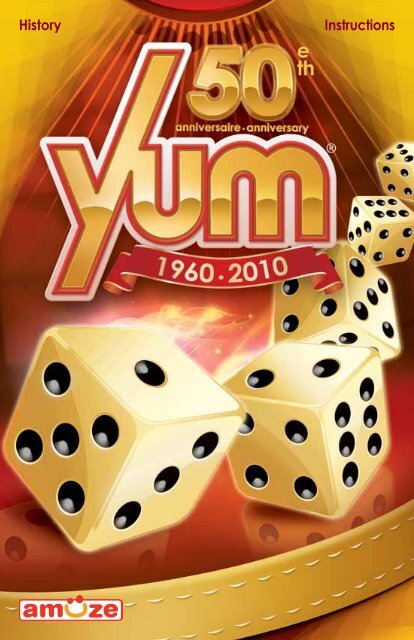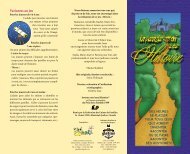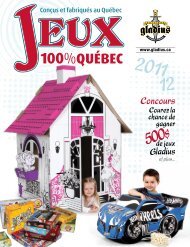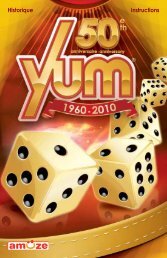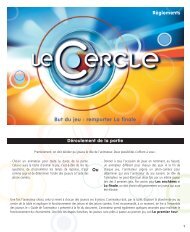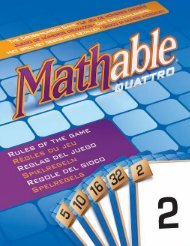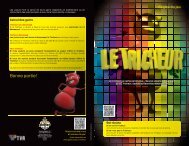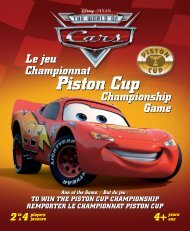Download Yum historic booklet - Gladius
Download Yum historic booklet - Gladius
Download Yum historic booklet - Gladius
You also want an ePaper? Increase the reach of your titles
YUMPU automatically turns print PDFs into web optimized ePapers that Google loves.
History<br />
Instructions
South America and was popularized on Spanish<br />
ships in the Caribbean and the South Seas, as<br />
well as by Pirates!<br />
Background Information<br />
Played by two or more participants, poker dice<br />
games were popular with sailors and viewed<br />
as a way to pass the time pleasantly while they<br />
were at sea. The games required little explanation<br />
and few materials. Poker dice games were<br />
popular in most ports in the 1950s, and even<br />
today dice games may be found in marinas<br />
and yacht clubs.<br />
Many families have long played these games<br />
at home, at the cottage and on their boats<br />
before the games were commercialized.<br />
At the time, poker dice games consisted of<br />
playing dice with materials made by hand,<br />
with no rules or standardized tally sheets.<br />
Grinsell’s idea behind the creation of YUM ®<br />
was to unify these standards and develop a<br />
marketable version.<br />
1970<br />
This timing of the offer was perfect for Mr. Grinsell,<br />
now overwhelmed by the growing success<br />
of YUM ® and experiencing difficulty meeting<br />
the many steps required for the sale of his<br />
game. To lighten his workload and broaden his<br />
horizons, Mr. Grinsell finally accepted the Parker<br />
Brothers proposal.<br />
It was the pleasure of being with friends and<br />
family playing various games, talking and<br />
having fun for hours that would prompt<br />
Canadian Harvey Grinsell, of American origin,<br />
born in 1908 in Rhode Island, to embark on a<br />
huge endeavour. After noting the contentment<br />
provided by the hours of pleasure playing<br />
poker dice, he developed an idea that would<br />
change his life and family evenings in Quebec.<br />
Thus, during the 1950s, Mr. Grinsell developed a<br />
commercial version of poker dice games and<br />
various non-standard scorecards that have<br />
brightened family gatherings for longer than<br />
one can remember.<br />
After many hours of<br />
work on the concept<br />
in 1959, he finally<br />
managed, in 1960,<br />
to market the game,<br />
known today as<br />
YUM ® .<br />
Mr. Harvey Grinsell & Son,<br />
Jacques Grinsell<br />
A bit of history...<br />
For thousands of years, people have been<br />
rolling dice for fun. The earliest dice used<br />
for entertainment were made of sheep<br />
bones. A person would win if<br />
the bones fell on a particular<br />
side. The cubic dice we know<br />
today made their first<br />
appearance about<br />
5000 years ago<br />
and were made<br />
mainly of bone, ivory<br />
and stone.<br />
From the onset, dice were designed so that the<br />
sum of two opposite sides would equal seven,<br />
which means, one facing six, three facing<br />
four and two facing five. Archaeologists have<br />
found some of the oldest dice in many tombs<br />
in the region of India, thus highlighting their<br />
Asian origin. Digital typography had yet to be<br />
invented at the time, so this is why there are<br />
small dots on the dice, an aspect that has been<br />
preserved until today.<br />
Like the first dice games, poker dice games<br />
also have Asian origins. These origins explain,<br />
among other reasons, the inspiration behind<br />
Mr. Grinsell’s choice of name and the first<br />
packaging design of YUM ® .<br />
These dice games were popular on boats and<br />
ships that traveled the spice route to Spain.<br />
In fact, in Spain, there is a dice game known<br />
as Liar’s Poker Game. This game originated in<br />
1960<br />
After launching the game in 1960, Mr. Grinsell<br />
oversaw the many steps and activities needed<br />
to meet the demand. After preparing the boxes<br />
and printing the instructions, he assembled<br />
each component of the game in his house with<br />
the help of family members.<br />
The game’s entrance on the market was a<br />
success. Offered at Eaton’s and Simpson’s at<br />
the time, the family game soon attracted the<br />
attention of the largest toy producers in the<br />
world. Seeing the success of his first game,<br />
Mr. Grinsell decided to market a second<br />
game, called Ambition. This same game was<br />
later renamed <strong>Yum</strong> ® Ambition, a game that<br />
may be found in the YUM ® special 50 th anniversary<br />
edition. In 1966, recognizing the<br />
immense potential and future of YUM ® , Parker<br />
Brothers, known for its Monopoly game,<br />
offered to purchase rights to produce the<br />
game from Mr. Grinsel.<br />
1975<br />
1991<br />
A few years later, in 1991, Hasbro, a leader in<br />
the toy market, decided to expand its product<br />
line by acquiring one of its competitors, Parker<br />
Brothers. Following this transaction and the<br />
death of Mr. Grinsell in 1986, his son, Jacques<br />
Grinsell, recovered the rights previously granted<br />
to Parker Brothers to follow in the footsteps of<br />
his father.<br />
Subsequently, Jacques Grinsell made the<br />
acquaintance of the Richer family and the<br />
Bojeux company from Montreal. They proposed<br />
to refresh the presentation of the game and<br />
launch a completely redesigned YUM ® on the<br />
market. The agreement between Jacques<br />
Grinsell and the Richers not only breathed new<br />
life into the game, but also paved the way for<br />
a growing local success story.<br />
2<br />
3
Today, Wooky Entertainment’s team continues<br />
to spread the YUM ® brand in collaboration with<br />
Jacques Grinsell, Editions <strong>Gladius</strong> and several<br />
new partners.<br />
1995<br />
Instructions<br />
In 1995, Jacques Grinsell raised the idea of<br />
developing a new version of YUM ® to introduce<br />
it to children. By combining the YUM ® classic<br />
game with animal illustrations, Jacques Grinsell<br />
gave young people the opportunity to learn<br />
while having fun playing Safari YUM ® ! The first<br />
version of the game was officially launched on<br />
August 1, 1995 and is still widely popular. Other<br />
new versions of the game were also launched:<br />
YUM ® Ambition, YUM ® Bingo!, YUM ® Dora the<br />
Explorer TM and YUM ® SpongeBob TM !<br />
Following the huge success of the brand in<br />
2007, YUM ® and Loto-Quebec joined forces<br />
and launched a new instant game: the lottery<br />
scratch YUM ® . Again, it was a success: two<br />
series of instant lotteries were sold between<br />
2007 and 2009, leading to over 15 million<br />
dollars in sales. In addition, to celebrate the<br />
50 th anniversary of YUM ® , in September 2010<br />
Loto-Québec launched another instant lottery<br />
special edition to celebrate the success of this<br />
100% local game.<br />
From its introduction in the 1960s, YUM ®<br />
continues to evolve with even more prestigious<br />
projects such as the organization of a<br />
YUM ® tournament in Quebec, the launch of a<br />
YUM ® iPhone application, the introduction of<br />
the new Cross YUM ® - a written version to play<br />
in magazines and newspapers - and a new<br />
interactive website.<br />
In the year 2010, Wooky Entertainment’s entire<br />
team is proud to celebrate with you the 50 th<br />
anniversary of YUM ® , the most popular poker<br />
dice game loved by families everywhere!<br />
<strong>Yum</strong> ® for<br />
Iphone<br />
2009<br />
www.playyum.com<br />
YUM ® Classic<br />
Aim of the Game<br />
To collect the most points<br />
through dice combinations. Players<br />
must try to complete the dice combinations<br />
entered on their score sheet by collecting<br />
the greatest possible number of points. To<br />
achieve this, a player is entitled to roll the dice<br />
up to three times per turn. If the player fails to<br />
complete a combination after the third roll, the<br />
player may add up his or her points in the most<br />
advantageous way possible.<br />
Before Playing the Game<br />
Each player takes a score sheet and places it<br />
nearby on the table. Players choose at random<br />
who goes first. The game is played clockwise.<br />
The first player places the dice in the cup.<br />
Playing the Game<br />
The first player rolls the dice. Based on the<br />
numbers obtained on this first roll, the player<br />
decides what combination to attempt. The<br />
player leaves the dice chosen to make the<br />
combination on the table and then rolls the<br />
remaining dice. The player may also choose<br />
to roll the five dice a second time. A player<br />
may roll the dice a maximum of three times<br />
per turn. If the player completes the combination<br />
on the second turn, points are compiled<br />
and the player does not roll the dice a<br />
third time. Then the next player takes a turn.<br />
If a player fails to obtain a combination after<br />
three rolls of the dice, the player must tally the<br />
score obtained to his or her best advantage.<br />
Example:<br />
While trying to complete<br />
a FULL HOUSE (three of a kind and another<br />
pair), the player ends his or her turn with<br />
three 6’s, one 2 and one 3. The player can<br />
add the three 6’s together and enter a score<br />
of 18 in the sixth square of the “ROLL 1’s, 2’s,<br />
3’s, 4’s, 5’s, 6’s” or enter 18 in the “3 of a KIND”<br />
square of the score sheet.<br />
A player may make only one combination per<br />
turn of play. For example, if the player rolls a<br />
FULL HOUSE on the third roll and a FULL HOUSE<br />
score has already been entered on his or her<br />
score sheet, the player must tally the score<br />
obtained to his or her best advantage and<br />
enter it in another square.<br />
Example: Three 6’s and two 5’s can be scored<br />
to total 28 points in the HIGH ROLL square OR<br />
the 6’s can been added for a total of 18 in<br />
the sixth square of “ROLL 1’s, 2’s, 3’s, 4’s, 5’s,<br />
6’s”,OR the five dice may be totalled as 10 in<br />
the fifth square of the same section.<br />
If these alternatives have already been<br />
scored and entered, the player must enter “0”<br />
in another square of his or her choice. When<br />
all players have completed their thirteen combinations,<br />
their total scores are compiled. The<br />
player with the highest score wins the game.<br />
4 5
Upper Half<br />
• ROLL 1’s, 2’s, 3’s, 4’s, 5’s, 6’s<br />
The total number of one kind in three throws,<br />
for example:<br />
• SHORT STRAIGHT OF 4<br />
Score 15 points for any sequence of<br />
4 consecutive numbers, for example:<br />
Instructions<br />
YUM ® Ambition<br />
Aim of the game<br />
Validating the dice<br />
(3 + 3 + 3) scores 9 points in the 3’s box.<br />
• BONI<br />
If a player scores 63 points or more in the upper<br />
section (1’s through 6’s), that player earns a<br />
bonus of 25 points.<br />
Lower Half<br />
• 3 OF A KIND<br />
Three dice match, score the total of all of the<br />
dice (3 of a kind + the other 2 dice).<br />
scores 15 points in the<br />
SHORT STRAIGHT of 4 box.<br />
• LONG STRAIGHT OF 5<br />
Score 20 points for any sequence of<br />
5 consecutive numbers, for example:<br />
scores 20 points in the LONG STRAIGHT of 5 box.<br />
• HIGH ROLL<br />
Any combination of dice faces whenever the<br />
player chooses to use it. Tally the total of all the<br />
dice faces, for example:<br />
To be the first player to obtain 5 000 points.<br />
Playing the game<br />
The oldest player starts the game. The game is<br />
played clockwise and each player must qualify<br />
before obtaining points.<br />
To qualify, each player must throw the dice<br />
three times in order to obtain an and<br />
a .<br />
Once the player throws and obtains 3 identical<br />
dice, he must throw the dice again in<br />
order to obtain a or a to validate<br />
his trio. Once validated, the points obtained<br />
by the validation dice are added to the points<br />
already earned. If the player has not been<br />
successful in validating his trio, he automatically<br />
loses the points obtained for this turn.<br />
The only two dice used for validation are<br />
the and the . Once a player has<br />
If the player does not qualify with these three<br />
decided to stop and register his points he<br />
(4 + 4 + 4 + 5 + 6) scores 23 points<br />
in the 3 OF A KIND box.<br />
• 4 OF A KIND<br />
Four dice match, score the total of all the dice<br />
(4 of a kind + the other die).<br />
(2 + 2 + 2 + 2 + 4) scores 12 points<br />
in the 4 OF A KIND box.<br />
(1 + 2 + 4 + 4 + 6) scores 17 points<br />
in the HIGH ROLL box.<br />
• FULL HOUSE<br />
Tally 25 points for three of a kind and another<br />
pair, for example:<br />
scores 25 points in the FULL HOUSE box.<br />
throws, he must pass the dice to the player<br />
to his left.<br />
Scoring points<br />
Each time a player throws the dice, he must<br />
obtain points. The player has the choice of<br />
accumulating points, based on his ambition,<br />
or to stop. If the player decides to throw the<br />
dice again and does not obtain any points,<br />
cannot lose them.<br />
The first player to accumulate 5 000 points is<br />
the winner. However, this must be achieved<br />
by throwing the “exact” count to complete<br />
the 5 000 points at his last throw. Increase your<br />
pleasure by playing as a team. Use one score<br />
sheet per team.<br />
• YUM<br />
Tally 30 points for five numbers of one kind,<br />
for example:<br />
he loses the accumulated points for this turn.<br />
Attention… Ambition devours its slave!<br />
scores 30 points in the YUM box.<br />
Enjoy the game!<br />
50 points 100 points<br />
200 points<br />
500 points<br />
300 points<br />
600 points<br />
400 points<br />
1000 points<br />
6
www.playyum.com<br />
Printed in Canada<br />
© 2010<br />
www.wookyentertainment.com<br />
All graphics, illustrations, product and<br />
packaging designs are copyrights © 2010<br />
of Wooky Entertainment inc. All rights reserved.


